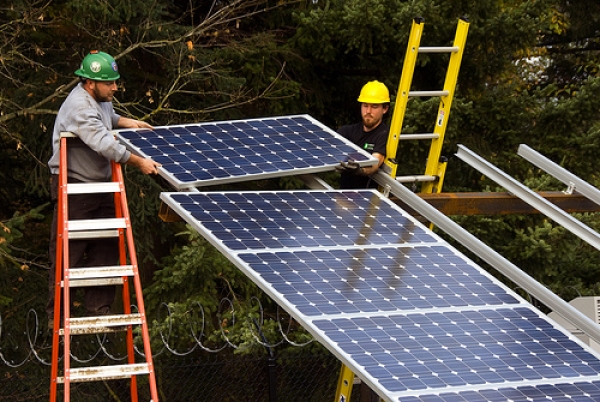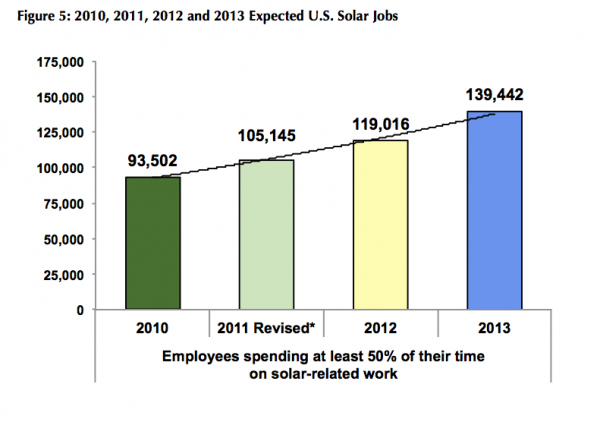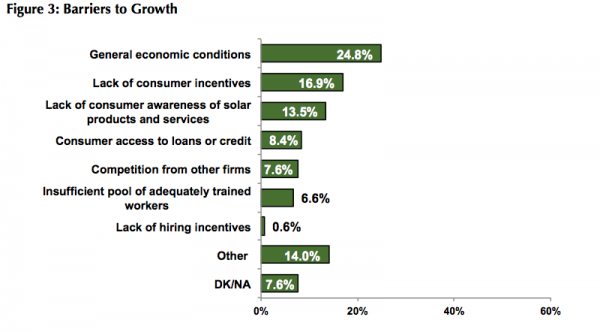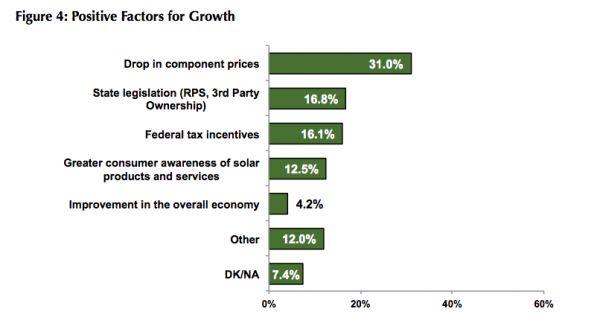 Solar’s soaring job growth keep boots on the roofNov. 27, 2012 - Felicity Carus - pv-tech.org  Job growth in the US solar sector has outstripped the national average. Image credit: Oregon DOT.
The National Solar Jobs Census 2012 published earlier this month revealed that solar companies are hiring faster than the general economy. The Solar Foundation's review of the US solar workforce found that as of September 2012, the solar industry had grown to 119,016 workers under its definition of those "who spend at least 50% of their time supporting solar-related activities".
Project job growth in the US according to the Solar Foundation solar jobs review
"There are 119,016 solar workers in the United States, up from a revised 105,145 in 2011," the report said. "In just five years, the industry grew nearly six times in value, with total solar installations in the US estimated to be worth $8.4 billion in 2011."
Respondents to the Solar Foundation solar jobs review cited economic conditions, lack of consumer incentives and consumer awareness as the top three barriers to growth
Since 2010, when the foundation began tracking jobs, solar industry employment has grown by 27% to a figure that outstrips the 91,611 coal miners in the US, according to Energy Information Administration. It goes without saying that most of that job creation was with installers (48%), rather than manufacturers (25%). Although numbers of employment establishments contracted by 2,000 to 15,000, solar employment overall is expected to grow by 17.2% over the next 12 months, representing the addition of approximately 20,000 new solar workers.
The drop in component prices has been the most positive factor for growth, according to the Solar Foundation
"A decline in establishments, coupled with increased employment, suggests consolidation and maturation of the industry," said the report. "Solar employment is growing nearly six times faster than the national average employment growth rate of 2.3%, and many sectors across the various conventional energy generation industries either grew more slowly or experienced employment declines. For example, over the last year, the fossil fuel electric generation sector lost nearly 4,000 workers, and jobs in coal mining fell by 850." Randy Bishop started Verengo Solar from the ashes of a window company in 2008, "right in the heart of the whirlwind". The company recently celebrated its 5,000th installation. Bishop's California residential solar installation company employed 400 people last year, and is on track to hire another 400 next year. "I feel like especially during an election cycle there's been such a focus on the negatives," he said during a Vote Solar press call last week. "The reality is that during some really tough times over the past few years, companies like Verengo Solar have been growing and creating a lot of jobs, saving customers money in meaningful ways during a recession. "A large percent of these are blue collar jobs and even within those construction trade jobs, electricians, roofers … these types of jobs were hit particularly hard in the recession. That has been where the bulk of our growth and hiring has been [also in] call centre and sales jobs that don't require college education. In today's economy, these are incredibly valuable jobs because we have a workforce that can't all compete in the knowledge economy." Mike Hall, CEO of Borrego Solar, started his company in 2002 at his parents' house in San Diego. Borrego is now delivering small and medium scale utility projects to corporations, cities, counties public schools colleges and university. Its biggest client couldn't get much bigger: the Department of Defense; Borrego recently completed a 3.4MW installation at Edwards Air Force Base in California. Borrego employs 100 people nationwide and 100 additional sub-contractors annually. "The most important part of the solar industry story is not being discussed in Washington and it's hardly a part of the political discourse," said Hall. "When I started in the industry 10 years ago, you could fit the entire industry into a large ballroom. The industry employed hundreds of people full time and a few more part time. Now the industry employs more than 100,000 people. Ten years ago a small utility-scale system cost over US$7/watt to construct. Now ten years later the cost is closer to US$2.50/watt – that's a 65% reduction without taking into account that systems are often more efficient." Beyond the lack of recognition for solar's contribution to employment figures, a further source of frustration for Bishop is the additional cost to solar systems resulting from inefficient local permitting procedures. Solar customer Bill Gardner described his pleasant experience of having a 40-panel system installed by SunRun: "I was amazed the very first time the power came on from the solar system and I watched the meter stop and start going backwards. I watch my electric power bills drop dramatically. We save around $1,200 a year on what would have been the electric bill." But although it took the installation crew only a day and a half to install, they flicked the switch – and promptly shut the system down for over three weeks while PG&E connected the system and the city officials gave the system their "blessing". Bishop said that these highly localised permitting requirements are far from standard. One local authority might ask for life-sized blueprint sketches, while others only want a computer design emailed to them. "That creates lots of trips to permitting agencies and becomes a barrier for firms to really expand because we have to navigate this morass. It adds a lot of unnecessary costs to the system," he said. These "soft" permitting and interconnection costs with utilities make installed system prices $2.70/watt more expensive than in Germany, according to a recent report from Lawrence Berkeley National Laboratory. Adam Browning, Executive Director of Vote Solar, said: "These unnecessary costs…are cumulative and slow down business opportunities, so it points to simple policy fixes in some cases. Local leaders at a local level can help a lot in bringing solar to scale. We don't need magic new double efficiency solar panels to get a tremendous change in solar's costs. A lot of this is about getting smarter." As new garage-to-riches solar stories are added to America's entrepreneurial folklore, from Thomas Edison to Steve Jobs, some of the fixes may be smart, but many will be no-brainers.
|


